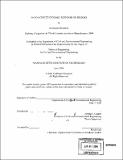Wind-induced dynamic response of bridges
Author(s)
Rousseau, Guillaume, 1982-
DownloadFull printable version (2.999Mb)
Other Contributors
Massachusetts Institute of Technology. Dept. of Civil and Environmental Engineering.
Advisor
Jerome J. Connor.
Terms of use
Metadata
Show full item recordAbstract
Wind loading has long played a significant role in bridge design. Some spectacular failures, such as the Tay Bridge (Scotland, 1879), or the Tacoma Narrows Bridge (Washington State, 1940) acted as a painful reminder to engineers in case they had forgotten the importance of wind loading. Today, a constant drive for longer spans in suspension or cable-stayed bridges forces designers to give even more care to wind load. The Golden Gate Bridge (1280 m, San Francisco, built in 1937), which held the record for the longest span for 27 years, is now a distant 7th to the Akashi-Kaikyo (1991 m, Japan, 1998). Different in many ways, the current hunger of Japan and China for new infrastructure leads a renewal of innovation in bridge design and wind engineering. A few projects in Europe or the United States, like the Great Belt Bridge (1624 m, Denmark, 1998), or the Messina Bridge project (3300 m, Italy, not built) are part of the same trend. The design of such a structure is a real challenge for the designer. A good example is given by the Messina Bridge in Veneziano and Van Dyck, 1998. Wind loading in different directions, determination of the reference wind speed, earthquake load, numerous cases of traffic loading ... are investigated thoroughly. The intent of this thesis is to present the essentially dynamic behavior of bridges submitted to wind. The main phenomenon involved will be exposed, as well a method to evaluate the maximum response for given wind conditions. Theories and methods developed by A.G. Davenport and R.H. Scanlan support most of the developments in this text. (cont.) This thesis will not deal with specific design issues, the analysis of the response being already quite an extensive topic. Rather, its purpose is to give the reader a better understanding of wind engineering, in the belief that good design is a complete thinking process based on understanding of the underlying behavior, and not the application of straightforward recipes. This is particularly true when dealing with those high-performance structures mentioned above.
Description
Thesis (M. Eng.)--Massachusetts Institute of Technology, Dept. of Civil and Environmental Engineering, 2004. Includes bibliographical references (leaves 52-54).
Date issued
2004Department
Massachusetts Institute of Technology. Department of Civil and Environmental EngineeringPublisher
Massachusetts Institute of Technology
Keywords
Civil and Environmental Engineering.